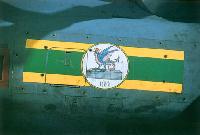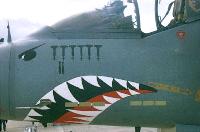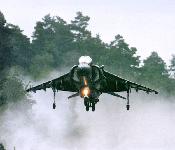Фотографии
-
Регистрационный номер: ZD323 Harrier GR.5 ZD323 'C' of 233 Operational Conversion Unit, Wittering, circa late 1987. Upper surfaces were NATO Green with Lichen Green on the under surfaces. Tactical roundels of reduced size were applied to the fuselage and the upper port and lower starboard wings.
Самолёты на фотографии: BAe Harrier GR Mk.5 - Великобритания - 1979
-
Регистрационный номер: ZD329 Harrier GR.7 ZD329 'H' of 20(R) Squadron, 233 OCU, Cottesmore, 1975. Finish was the same as the GR.5.
Самолёты на фотографии: BAe Harrier GR Mk.5 - Великобритания - 1979
-
Регистрационный номер: ZG512 Harrier GR.9 ZG512 ‘83’ of 4 Squadron, Cottesmore, 1987. The current Harrier camouflage scheme consisting of Dark Sea Grey with Dark Camouflage Grey on the under surfaces
Самолёты на фотографии: BAe Harrier GR Mk.5 - Великобритания - 1979
-
Newer-style of 4 Squadron badge as applied to the unit's GR.7s. The badge features a sun in splendor divided per bend by a flash of lightning. The red and black segmented sun suggests round-the-clock operations, while the lightning flash is a reference to the squadron's early use of wireless telephony for artillery co-operation
Самолёты на фотографии: BAe Harrier GR Mk.5 - Великобритания - 1979
-
Harrier GR.5 in original green livery
Самолёты на фотографии: BAe Harrier GR Mk.5 - Великобритания - 1979
-
Регистрационный номер: ZD404 GR.7A ZD404 tucks up its gear during a hover at Wittering. The re-engined GR.7A is fitted with a more powerful Pegasus 107. They can be easily identified by the addition of an 'A' after their tail codes. Note also that 20(R) Squadron jets still bear traces of the 233 OCU badge on their tails
Самолёты на фотографии: BAe Harrier GR Mk.5 - Великобритания - 1979
-
No.3 Squadron badge on a GR.7. On a monolith, the badge features a cockatrice and was approved by King George VI in September 1937. The cockatrice was chosen because in mythology it was the first creature to fly.
Самолёты на фотографии: BAe Harrier GR Mk.5 - Великобритания - 1979
-
Superb comparison shot with a 4 Squadron GR.7 in the foreground joined by one of the unit’s GR.3s. The GR.7 wears the then new but now obsolete two-tone green paintwork, while the GR.3 sports wrap-round grey/green camouflage. No.4 received its first GR.7 in September 1990, with nine of the new variants being on strength by the end of the year. The last GR.3 sortie with the unit was flown in December 1990 while 4 Squadron was still based in West Germany as part of the RAF Germany Harrier Force.
Самолёты на фотографии: BAe Harrier - Великобритания - 1966BAe Harrier GR Mk.5 - Великобритания - 1979
-
No. 1 Squadron badge, featuring a winged numeral '1'. It was approved by King Edward VII in July 1936 as the authorised version of a badge which had originated during World War One, featuring a wreathed roundel from which sprouted a pair of Royal Flying Corps wings and on which the figure '1' was superimposed
Самолёты на фотографии: BAe Harrier GR Mk.5 - Великобритания - 1979
-
Регистрационный номер: ZD408 Harrier GR.7 ZD408 of 4 Squadron as it appeared on May 7, 2003, the day of its return to Cottesmore, Leics, from deployment to the Gulf as part of Operation Iraqi freedom. Shark's mouths and mission marks were applied to several of the unit's Harriers.
Самолёты на фотографии: BAe Harrier GR Mk.5 - Великобритания - 1979
-
Регистрационный номер: ZG511 Featuring upgraded avionics, the first GR.9 to enter service was ZG511, Cottesmore in November 2005, of 1 Squadron.
Самолёты на фотографии: BAe Harrier GR Mk.5 - Великобритания - 1979
-
На фотографии хорошо видны переделанная носовая часть и большое крыло самолета GR.Mk 5 из состава 1-й эскадрильи с запускаемой УР AIM-9 Sidewinder.
A Harrier GR.5 ofl Squadron lets loose a Sidewinder. Due to various improvements, the newer generation of the famous V/STOL aircraft could carry double the payload or fly twice the range of its predecessors.Самолёты на фотографии: BAe Harrier GR Mk.5 - Великобритания - 1979
-
Harrier GR.7s of 1 Squadron en route to Norway on January 23, 2004, ready to participate in Exercise SNOW falcon. The modern arctic camouflage can be compared with the older style in the earlier picture showing the unit's GR.3s.
Самолёты на фотографии: BAe Harrier GR Mk.5 - Великобритания - 1979
-
A 3 Squadron GR.5 blasts off from a forward operating site in West Germany. The RAF Germany Harrier Force spent many weeks each year operating in the field, using the Harrier's extreme tactical capability to its optimum.
Самолёты на фотографии: BAe Harrier GR Mk.5 - Великобритания - 1979
-
Регистрационный номер: XV755 Harrier GR.I XV755 of 1 Squadron, Wittering, Cambs, 1970. Gloss finish of Dark Green and Dark Sea Grey with Light Aircraft Grey under surfaces. Red/white/blue roundels in six positions. The badge of RAF Wittering appeared above the fin flash.
Самолёты на фотографии: BAe Harrier - Великобритания - 1966
-
Регистрационный номер: XW767 Harrier GR.I XW767 'F'of 3 Squadron, Wildenrath, circa 1972-1974, in exercise markings. Matt finish with a combination of tactical red/blue and red/white/blue roundels.
Самолёты на фотографии: BAe Harrier - Великобритания - 1966
-
Регистрационный номер: ZD668 Harrier GR.3 ZD668 'J' of 4 Squadron, Gutersloh, circa 1987. Matt finish with tactical roundels in six positions. The fin markings were initially applied to commemorate the Squadron's 75th anniversary, but they spread to other aircraft.
Самолёты на фотографии: BAe Harrier - Великобритания - 1966
-
Самолёты на фотографии: BAe Harrier - Великобритания - 1966
-
Регистрационный номер: XV279 Development batch Harrier GR.I XV279 oozes the nostalgia of the type's early service days complete with three-colour roundels. It remains in the care of the RAF and is seen here at Wittering, Cambs, on February 21, 2006. It is still used for ground crew tow-training.
Самолёты на фотографии: BAe Harrier - Великобритания - 1966
-
Регистрационный номер: XZ971 From the late 1970s until July 1993 the RAF operated Harrier GR.3s in Belize with 1417 Flight. The unit had a ‘sailfish’ badge, here seen applied to XZ971 at Wittering in July 1993 after its return ferry flight
Самолёты на фотографии: BAe Harrier - Великобритания - 1966
-
During late 1992, 233 OCU at Wittering was assigned the 20(R) Squadron numberplate - this unit still operates as the Harrier OCU. No.20 had earlier operated GR.ls at Wildenrath in West Germany from 1970 to 1977. The unit's badge is seen applied to a GR.3. It depicts an eagle, wings elevated and perched on a sword in front of a rising sun.
Самолёты на фотографии: BAe Harrier - Великобритания - 1966
-
Badge of 233 Operational Conversion Unit as applied to a GR.3. The Harrier Conversion Unit became 233 OCU on October 1, 1970. The unit was originally formed at Pembrey, Wales, on September 1, 1952, and its badge depicts a Welsh Wildcat.
Самолёты на фотографии: BAe Harrier - Великобритания - 1966
-
Регистрационный номер: XV808 GR.3 XV808 of 233 Operational Conversion Unit kicking up the dust during a typically spectacular display at Duxford, Cambs, in 1986. The GR.3 became more familiar with its Ferranti Laser Ranging and Marked Target Seeking (LRMTS) equipment fitted into the distinctively-shaped nose.
Самолёты на фотографии: BAe Harrier - Великобритания - 1966
-
A brace of 1(F) Squadron GR.3s in temporary arctic camouflage returning from Norway in 1988. The white paint was water-soluble so that the jets could be returned to their grey/green temperate scheme relatively easily.
Самолёты на фотографии: BAe Harrier - Великобритания - 1966
-
Old-style 4 Squadron flash as used on the unit's GR.3s and T.4s.
Самолёты на фотографии: BAe Harrier - Великобритания - 1966
-
Harrier GR.l XV755 of 1 Squadron, Wittering, Cambs, 1970. Gloss finish of Dark Green and Dark Sea Grey with Light Aircraft Grey under surfaces. Red/white/blue roundels in six positions. The badge of RAF Wittering appeared above the fin flash. The upper and lower views show the camouflage pattern and the placement of underwing serials. These were progressively removed from RAF tactical aircraft from 1984.
Самолёты на фотографии: BAe Harrier - Великобритания - 1966
-
Регистрационный номер: XZ146 Two-seat Harrier T.4 XZ146 on a low-level sortie out of Wittering in July 1992.
Самолёты на фотографии: BAe Harrier T Mk.2 / T Mk.4 - Великобритания - 1969
-
Регистрационный номер: XW175 XW175 was one of two T.2 prototypes. The initial production fin of the two-seaters was 11in (27.9cm) taller than that on the single-seat variant, and later production T.2s had a further 18in (45.7cm) added to the height of their fins. Note also the lengthened tail cone.
Самолёты на фотографии: BAe Harrier T Mk.2 / T Mk.4 - Великобритания - 1969
-
Регистрационный номер: ZH663 Replacing the T.4 was the T.10 two-seat trainer, this example is from 20 Squadron. The first upgrade from T.10 to the next-generation T.12, ZH663, carried out its maiden flight on January 11 at BAE Systems’ airfield at Warton, Lancs
Самолёты на фотографии: BAe Harrier T Mk.10 / TAV-8B - Великобритания - 1986
Статьи
- Looking good for a Great Show
- Round-Out
- The Roundels File
- A.Ord-Hume - Three? One? Two? /Airliners and air services/
- B.Archer - Loyal Supporting Act /Air forces/
- C.Justo - Flying Start /History on the wing/
- D.Willis - Fairey's Versatile Gannet /Post-war combat/ (1)
- D.Willis - Military Auster A to Z /Production and industry/ (3)
- D.Willis - Second Generation AOP /Prototypes and experimentals/
- D.Willis - V for Variety /Air forces/ (1)
- G.Cruz, P.Hebrero - Spain's Big 'boats /Flying-boats and floatplanes/ (2)
- M.Rogers - Between a Rock and a Hard Place /World war one/
- S.Aloni - Best Form of Defence? Attack! /Post-war combat/ (1)




























